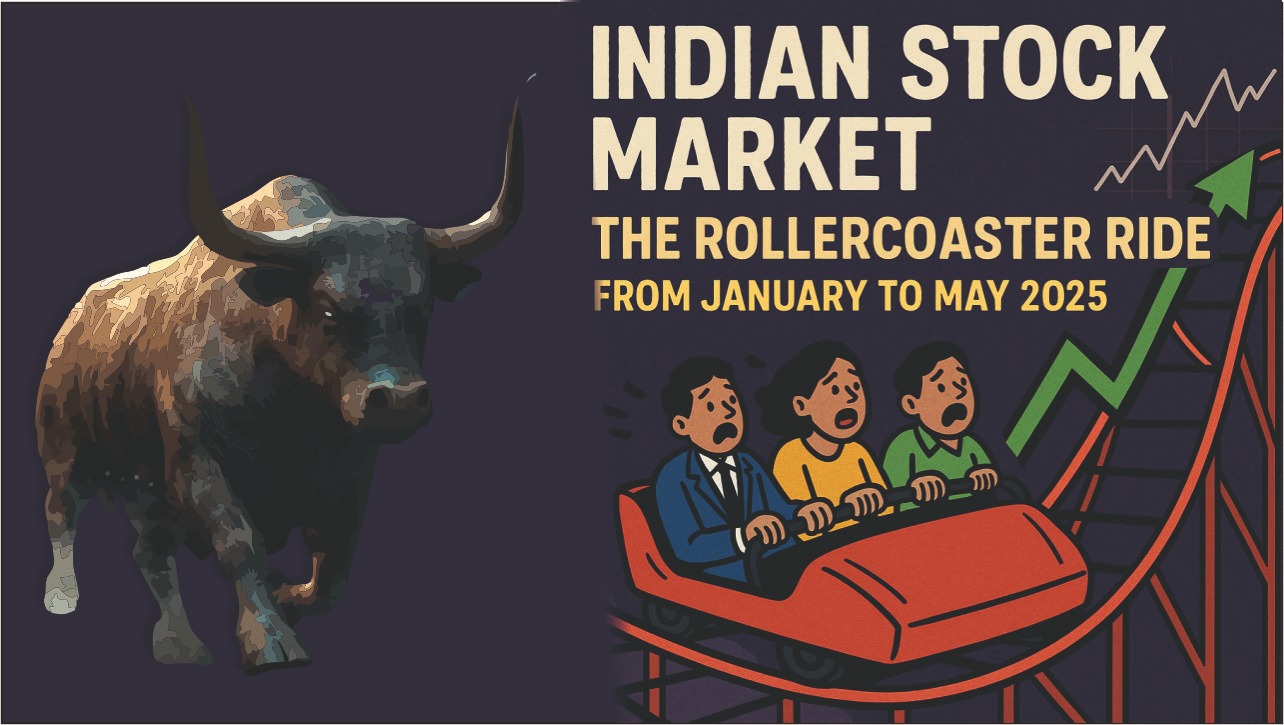Indian Stock Market: The Rollercoaster Ride from January to May 2025

Hey there, stock market enthusiasts! If you’ve been keeping an eye on India’s stock market from January to May 2025, you know it’s been one heck of a ride. Picture a Bollywood blockbuster—highs that make you cheer, lows that leave you gasping, and a whole lot of drama in between. The BSE Sensex and Nifty 50 have danced to a wild tune, driven by global trade tensions, domestic investor grit, and a sprinkle of economic surprises. So, grab a coffee (or chai, if you’re like me), and let’s unpack what went down in the Indian stock market over these five months, why it happened, and what it means for you.
The Big Picture: A Market That Took a Beating
Back in September 2024, the Indian stock market was on cloud nine. The Sensex hit a record high of 85,978, and the Nifty touched 26,277. Investors were buzzing, thinking the bull run would last forever. But then, things got real. By March 2025, the market had lost a staggering ₹90 lakh crore in total market capitalization, dropping from ₹474 lakh crore to ₹384 lakh crore. That’s like wiping out the GDP of a small country!
Big names like Tata (down ₹7.70 lakh crore), Adani (down ₹5.75 lakh crore), and Reliance (down ₹5.3 lakh crore) saw their market caps shrink faster than ice cream in the summer sun. By May 30, 2025, the Sensex closed at 81,451.01, down 182 points (0.22%), and the Nifty was at 24,750.70, down 82.90 points (0.33%). Despite the dips, the market was still up 4.24% year-to-date, showing some resilience. So, what caused this rollercoaster? Let’s break it down.
Why the Market Went Crazy
Several factors turned the market into a wild ride:
- Foreign Investors Bailed Out: Foreign institutional investors (FIIs) sold off Indian equities worth ₹98,950 crore since October 2024. Why? Indian stocks were looking pricey compared to other markets, corporate earnings were weaker than expected, and global trade tensions—especially after Donald Trump’s return as U.S. President—spooked investors. Trump’s talk of new tariffs on imports made emerging markets like India less attractive.
- Economic Slowdown: India’s GDP growth slowed to a 15-month low in early 2025. Corporate earnings for Q1 2025 were a mixed bag, with BSE100 companies reporting just 9% revenue growth in 2024 (down from 25% in 2023). Profits grew 32% thanks to cost-cutting, but that wasn’t enough to keep investors happy.
- Global Drama: A stronger U.S. dollar and a falling rupee (which hit multi-month lows) added pressure. Geopolitical tensions, like India-Pakistan border issues and conflicts in the Middle East, kept markets on edge. Meanwhile, the U.S. S&P 500 had its best May since 1990, up 6.3%, showing that global markets were a mixed bag.
- Domestic Strength: Despite the chaos, Indian retail investors and domestic institutional investors (DIIs) stepped up big time. They poured ₹1.54 trillion into NSE stocks by November 2024, breaking the 2021 record of ₹1.42 trillion. This kept the market from crashing harder.
Month-by-Month: What Happened When
Let’s take a closer look at how the market moved each month from January to May 2025, based on the data we’ve got.
January 2025: The Party Crashed
The year kicked off with a hangover from the 2024 correction. The Sensex dropped from 77,500.6 in early January to around 73,198.1 by February’s end—a rough 5-6% slide. The Nifty followed suit, falling below 22,500. Investors were jittery about slowing economic growth and FIIs pulling out cash. Corporate earnings reports showed weaker demand in consumer and industrial sectors, which didn’t help. But here’s a silver lining: small-cap stocks started showing some spark, with a few rallying up to 57% in a single month, hinting at a recovery in riskier bets.
February 2025: Hitting Rock Bottom
February was the low point. India’s share of global market capitalization dropped to 3% from over 4% in 2024. The Sensex and Nifty were down 15% and 15.82%, respectively, from their September 2024 peaks. Big conglomerates like Tata, Adani, and Reliance bore the brunt, losing massive chunks of their market value. The mood was grim, with analysts warning of further pain if global trade tensions worsened. But domestic investors kept the faith, pumping in billions to cushion the fall. By the end of February, there were whispers of a rebound as banking and infra stocks started to perk up.
March 2025: Signs of Life
March brought some much-needed relief. The Sensex and Nifty both gained nearly 7% for the month, driven by strong performances in banking and infrastructure sectors. Domestic institutional investors and some foreign portfolio investors (FPIs) started buying again, sensing that the market had hit a bottom. Analysts got optimistic, predicting the Sensex could climb to 78,500 by mid-2025 and 80,850 by year-end—still shy of its all-time high but a solid recovery. The early monsoon also boosted agri stocks, adding some green to the charts.
April 2025: Volatility with Hope
April was a mixed bag. The market stabilized, but volatility stuck around like an uninvited guest. Small-cap and mid-cap stocks stole the show, with some gaining for five straight days. The Nifty was projected to deliver a 19% return over the next 12 months, targeting 28,700 by year-end. Gold prices, which often act as a safe haven, grabbed attention too—they slipped ₹1,900 in four days but were expected to hit ₹1.10 lakh per 10 grams soon. Investors started to feel cautiously optimistic, though global cues like U.S. tariffs kept everyone on their toes.
May 2025: Holding Steady
By May 30, the Sensex and Nifty saw small dips—0.22% and 0.33%, respectively. But the broader market showed resilience. The NSE reported 1,130 stocks advancing and 1,446 declining, with active trading keeping the buzz alive. IT stocks, like those in the CNX IT Index, hit 37,471.55, and utilities held strong. Retail investors were still pouring in cash, driving record inflows. The market wasn’t back to its September 2024 glory, but it was fighting back.
Winners and Losers: Who Shone, Who Sank
Every market cycle has its heroes and zeros. Here’s who stood out (or didn’t) from January to May 2025:
-
Winners:
- Small-Cap Stars: Stocks like JSW Holdings and select small-caps delivered up to 57% returns in a month, especially in February and March. These riskier bets paid off for bold investors.
- Banking and Infra: Banking stocks, especially private banks, led the recovery in March. Infrastructure companies also got a boost from government projects worth ₹22,000 crore announced by PM Modi in May.
- Agri Stocks: An early monsoon in April and May lifted agriculture-related stocks, as investors bet on a strong harvest season.
-
Losers:
- Big Conglomerates: Tata, Adani, and Reliance saw massive market cap losses, with Tata alone losing ₹7.70 lakh crore. These giants struggled as investors shifted to smaller, high-growth stocks.
- Consumer and Industrial Stocks: Weak demand hit these sectors hard. Companies like Birlasoft and Alkem Labs dropped 4% after disappointing Q4 2024 earnings.
- High-Valuation Stocks: Stocks that looked overpriced in late 2024 were hit hardest when FIIs pulled out.
What Drove the Market’s Mood?
Let’s break down the key forces that shaped the market’s ups and downs:
- Retail Investor Power: Indian retail investors were the real MVPs. Their ₹1.54 trillion inflow into NSE stocks by November 2024 set a new record, beating the 2021 high of ₹1.42 trillion. This kept the market from a total meltdown, even as FIIs fled.
- Sector Shifts: Banking and infrastructure led the recovery, while consumer and industrial sectors lagged due to weak demand. IT stocks held steady, and agri stocks got a monsoon boost.
- Global Headwinds: Trump’s tariff threats, a stronger U.S. dollar, and a weaker rupee (hitting multi-month lows) hurt sentiment. Middle East tensions and India-Pakistan border issues didn’t help either.
- Domestic Optimism: Government spending, like the ₹47,000 crore worth of projects announced by PM Modi in Kanpur in May, kept hope alive. The Confederation of Indian Industry (CII) projected 6.5% GDP growth for FY26, signaling that India’s economy was still a global star.
What’s Next for Investors?
So, where do we go from here? The market’s been through a lot, but there’s light at the end of the tunnel. Here’s what you should keep in mind if you’re thinking about investing or just watching the markets:
- Stay Diversified: Don’t put all your eggs in one basket. Banking and IT stocks look solid, but consumer stocks need time to recover. Small-caps can be exciting but risky, so balance them with stable large-caps.
- Think Long-Term: The market’s 15% correction from September 2024 was rough, but history shows these dips usually resolve within months. If you’re in for the long haul, now might be a good time to buy quality stocks at lower prices.
- Watch Global Cues: Keep an eye on U.S. tariffs, the rupee’s value, and geopolitical news. These could keep the market volatile for a bit.
- Gold as a Backup: With gold prices swinging (down ₹1,900 in May but expected to hit ₹1.10 lakh), it’s a good hedge against market uncertainty.
- Monsoon Magic: The early monsoon is a big plus for agri stocks and rural demand, which could lift consumer stocks later in 2025.
Analysts are betting on the Nifty hitting 28,700 in the next 12 months, a 19% jump from May’s levels. The Sensex could climb to 80,850 by year-end, with some even eyeing 85,000 if global tensions ease. It’s not a smooth road, but there’s potential for gains if you play it smart.
The Bigger Picture: India’s Still a Star
Despite the market’s wild swings, India’s economy remains a bright spot. The Reserve Bank of India (RBI) says we’re still the fastest-growing major economy, with reforms and government spending acting like a safety net. Rural demand is picking up, and infrastructure projects are keeping the growth engine humming. Sure, global challenges like tariffs and geopolitical tensions are a headache, but India’s shown it can handle the heat.
Wrapping It Up
The Indian stock market from January to May 2025 was a classic tale of highs and lows. From losing ₹90 lakh crore in market cap to staging a partial recovery, it’s been a test of nerves for investors. Retail investors stepped up like heroes, banking and small-cap stocks showed grit, and government spending kept hope alive. But with global uncertainties lingering, it’s not all smooth sailing yet.
If you’re an investor, this is a time to stay sharp, diversify, and keep an eye on both local and global cues. The market’s down but not out, and with India’s economy still growing strong, there’s plenty of reason to stay optimistic. So, what’s your next move? Are you buying the dip, holding tight, or just watching the drama unfold? Let me know, and I’ll keep you posted on the latest market buzz!




